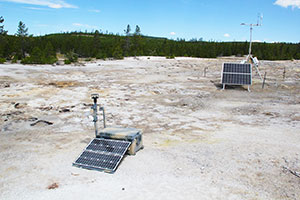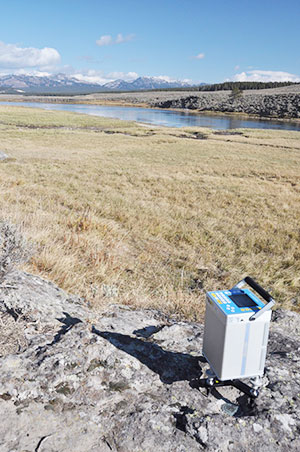
The Yellowstone Volcano Observatory (YVO), a consortium of nine regional scientific agencies, has released a new 10-year plan to improve monitoring and hazards assessment of volcanic, hydrothermal and earthquake activity in the Yellowstone Plateau region.
The University of Wyoming, led by Department of Geology and Geophysics Professor Ken Sims, is one of the YVO partners, along with the U.S. Geological Survey; the Wyoming State Geological Survey; Yellowstone National Park; the University of Utah; the Montana Bureau of Mines and Geology; the Idaho Geological Survey; Montana State University; and the scientific organization UNAVCO.
The Yellowstone volcanic system, formed over the past 2.1 million years by three massive caldera-forming eruptions and many smaller eruptions, is one of the most dynamic parts of the world for volcanic, hydrothermal and earthquake activity. Albeit quite improbable, the threat of another caldera-forming supereruption -- an explosive eruption with a volume of more than 1,000 cubic kilometers, or 240 cubic miles -- has serious implications for Earth's habitability, as it would dump significant amounts of ash on large swaths of the United States and have a long-term negative impact on the global climate due to ash and gas injected into the stratosphere. The potential of another supereruption from Yellowstone has drawn massive media attention and even fear-mongering hype in recent years.
Fortunately, there is no indication that any such activity is imminent, and the magmatic system beneath Yellowstone is mostly solid. But there are still many geological hazards in the region that pose a threat to people and must be monitored.
In an assessment of the threat posed by potentially active volcanoes in the United States, the Yellowstone caldera ranked 21st out of the 161 volcanoes considered, based on an assessment of volcanic histories, hazards and potential impacts on surrounding communities and air traffic. Earthquakes are another hot topic, as the Yellowstone region is one of the most seismically active areas of the United States, with an average of 1,500-2,500 temblors every year. Hydrothermal explosions are a concern as well, as they have created large craters inside the park, the most recent just 3,000 years ago.

Smaller hydrothermal explosions -- akin to unexpectedly large or uncharacteristic geyser events -- occur almost annually and could pose a hazard to anyone who is nearby if the event occurs in any of the thermal areas that are frequented by visitors.
"All of these geologic events have the potential to recur in the Yellowstone region, and some, especially small hydrothermal explosions and strong earthquakes, are likely to take place within the coming decades," the new monitoring plan says.
"The new Yellowstone volcano and earthquake monitoring plan builds upon improvements to monitoring systems in the region while also accounting for new insights into the dynamics of the area's seismic, volcanic and hydrothermal activity," says Sims, a National Geographic Explorer who researches volcanoes around the globe and has represented UW on YVO since 2013, soon after he moved to UW from a tenured research scientist position at Woods Hole Oceanographic Institution. "As such, this new monitoring plan will significantly enhance YVO's hazards forecasting capabilities, and it also will greatly facilitate scientific advances that will help geologists better understand how the Yellowstone system works."






